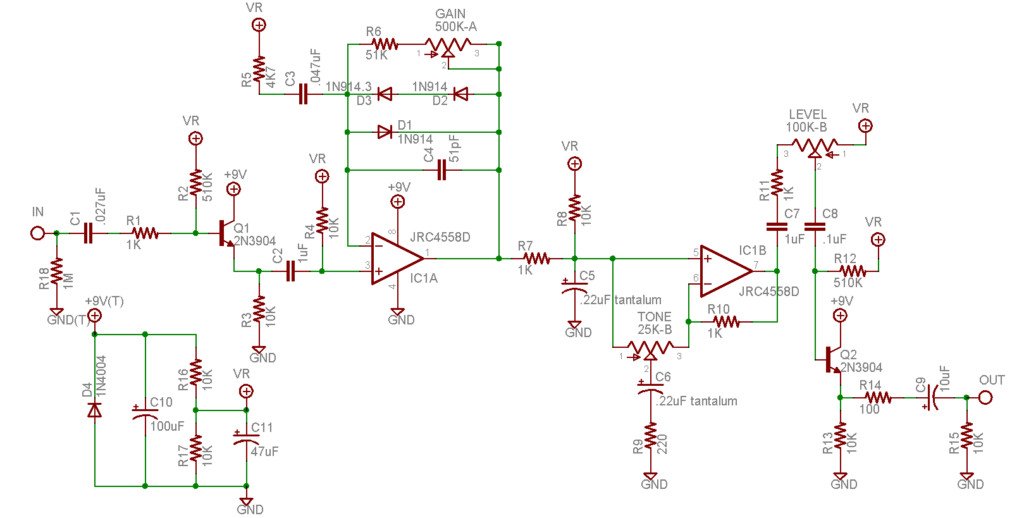Introduction: If you’re interested in building or modifying guitar pedals, learning how to read a pedal schematic is important. A pedal schematic is a diagram that shows the electronic parts and connections inside a pedal. In this blog post, we will guide you through the process of understanding a pedal schematic, making the world of electronics less confusing and empowering you to dive into pedal building.
- Get Familiar with Symbols: To read a pedal schematic, start by learning the symbols used for different parts. Components like resistors, capacitors, transistors, and integrated circuits have specific symbols. Take time to study these symbols and understand what each part does.
- Find the Power Supply Section: The power supply section is essential because it provides the voltage needed to run the pedal. Look for symbols representing power connectors, diodes, voltage regulators, and capacitors. Understanding how power is supplied and regulated will help you understand how the pedal works.
- Follow the Signal Flow: Signal flow is the path that an audio signal takes within the pedal. Start by finding the input and output jacks on the schematic. Then trace the signal path through different parts like op-amps, transistors, and other active or passive elements. Knowing the signal flow will help you troubleshoot and modify the circuit effectively.
- Understand Component Values: Schematics often show the values of components like resistors and capacitors. Resistors are represented by their resistance values in ohms, and capacitors are shown with their capacitance values in farads, microfarads (µF), or picofarads (pF). Pay attention to these values as they affect the pedal’s sound and performance.
- Learn Component Relationships: Components in a pedal schematic are connected in different ways. Resistors and capacitors might be connected in series or parallel, affecting the overall performance. Transistors and integrated circuits interact with other parts, amplifying or shaping the signal. Understanding these relationships helps you understand how the pedal functions.
- Check the Control Layout: Some schematics include a control layout diagram, showing the potentiometers, switches, and other user-adjustable parts. These diagrams help you understand how different settings affect the circuit. You can use this information to modify the pedal to suit your preferences.
- Seek Help Online: If you come across unfamiliar symbols or complex circuits, don’t hesitate to look for online resources or join DIY pedal-building forums. The pedal-building community is known for being helpful, and you can find explanations, insights, and troubleshooting tips to support you in your journey.
Conclusion: Learning to read a pedal schematic is an important skill for building or modifying guitar pedals. By understanding symbols, following signal flow, recognizing component values, and grasping component relationships, you can unravel the mysteries of pedal electronics. Enjoy the process of exploration and experimentation as you bring your pedal ideas to life and create unique sounds. Happy pedal building!


Guitar Pedal Order Diagram
Here is a simple diagram illustrating a common guitar pedal order:
Guitar –> Tuner –> Wah Pedal –> Overdrive/Distortion –> Modulation Effects (Chorus, Flanger, Phaser) –> Delay –> Reverb –> Amplifier
Explanation:
- Guitar: The starting point is your electric or acoustic guitar.
- Tuner: Use a tuner pedal to ensure your guitar is in tune.
- Wah Pedal: The wah pedal is an expressive effect that alters the tone of your guitar by emphasizing certain frequencies as you rock the pedal.
- Overdrive/Distortion: These pedals add grit and crunch to your guitar sound, ranging from mild overdrive to heavier distortion.
- Modulation Effects: This category includes pedals like chorus, flanger, and phaser. They create swirling, sweeping, and swirling effects to add depth and movement to your tone.
- Delay: Delay pedals produce repeated echoes of your guitar sound, creating spacious and ambient effects. You can adjust the delay time and feedback to control the number of echoes and their timing.
- Reverb: Reverb pedals simulate the natural reverberations of different spaces, adding depth and a sense of space to your sound.
- Amplifier: Finally, the signal from your pedals is sent to an amplifier, which amplifies the sound and adds its own tonal characteristics.
Remember, this is a general guideline, and you can experiment with different pedal orders to achieve the desired sound and effects. Also, keep in mind that personal preference and the specific pedals you’re using may influence the order or even necessitate some exceptions. Happy exploring and creating your unique guitar tones!


1 thought on “How to Read Pedal Schematic”